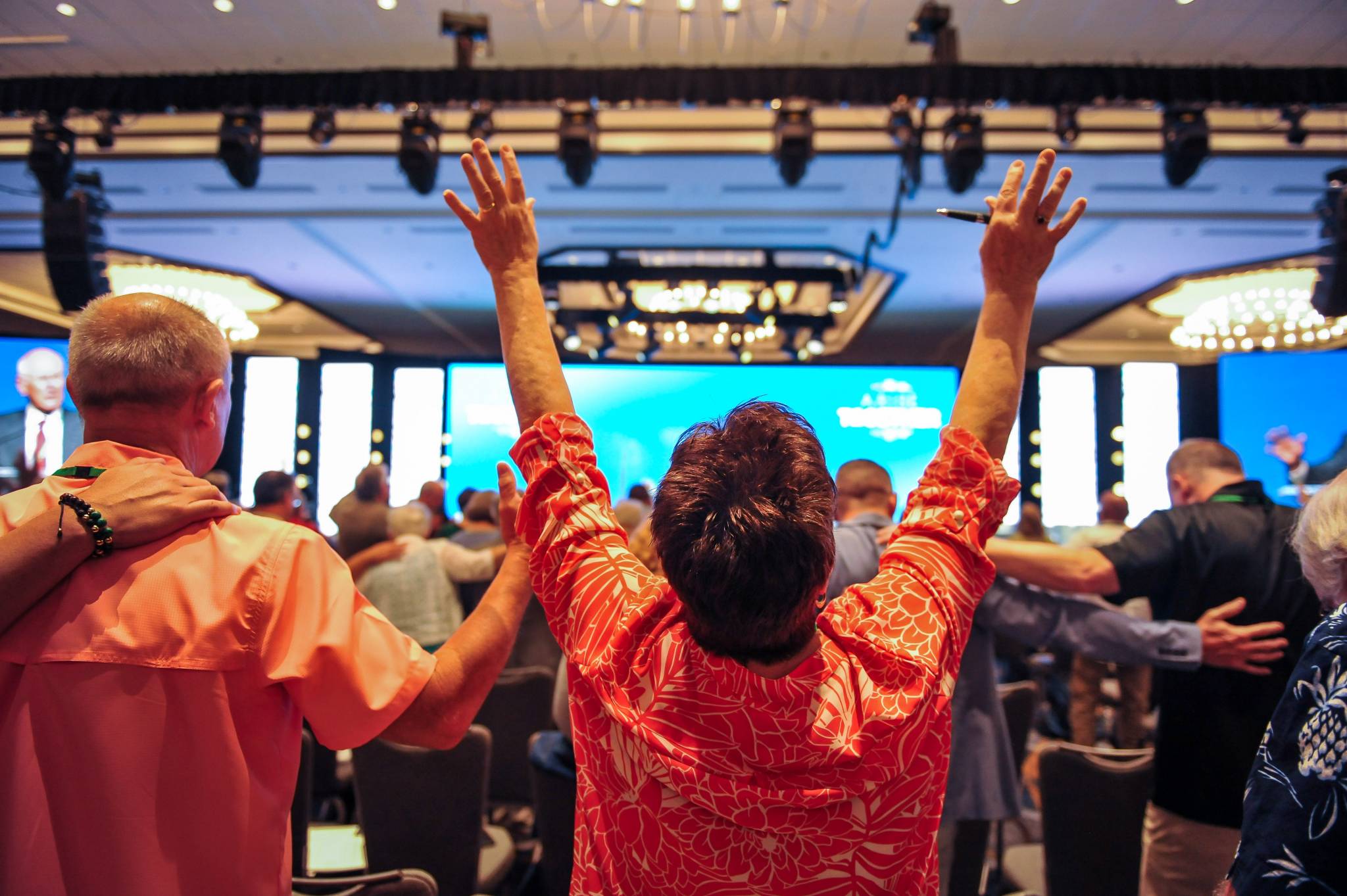Construction was completed in 1911, and the three-story building on the hill west of Bethany, Oklahoma, stood ready for occupancy.
Ironically, a historic meeting took place that same year in a tiny, one-room, octagon-shaped structure more than 1200 miles away. Leaders of the Pentecostal Holiness Church and the Fire Baptized Holiness Church convened in Falcon, North Carolina, to sign a merger agreement, uniting the two small denominations into one. As part of the blending, the larger of the two entities—Fire Baptized Holiness—agreed on a proposal to adopt the name of the smaller group, creating the movement known today as the International Pentecostal Holiness Church.
The following year (1912), that impressive building in Oklahoma opened under the name, St. Joseph’s Orphanage. Constructed by the Catholic Archdiocese of Oklahoma City as a place of hope for displaced children, the residence housed and cared for over 5,000 orphans from 1912 until its closing in 1965. Reports indicate that the rise of the foster care system and a shift in focus towards providing short-term placements for abused and neglected children led to the facility’s closure.
Meanwhile, following the merger of the two denominational groups in North Carolina, the Pentecostal Holiness Church operated without a specific headquarters until 1919, when it established its base of operations in Franklin Springs, Georgia. Since the General Superintendent, Bishop Joseph H. King, lived in Royston—the adjacent village—it seemed logical at the time that the denominational headquarters had found its “forever” home.
Yet, in 1952, under the oversight of Bishop Joseph A. Synan, the headquarters relocated for a short time to Memphis, Tennessee. However, at the 1961 General Conference, the delegation voted to return the offices to its former home in Franklin Springs. This move seemed financially expedient, since property and housing in a metropolis exceeded expectations. In “the Springs,” the general offices were housed once again in the denominational publishing house, Advocate Press (later to become known as LifeSprings Resources).
The Headquarters remained in Franklin Springs, Georgia, for 12 years before another shift was ratified and implemented.
When J. Floyd Williams was elected General Superintendent in 1969, one of his expressed mandates was to engender transformation in the denomination. In an interview with Dr. Vinson Synan, Williams stated that he saw his election to the church’s highest office as a “mandate for change.”[i][ii] One of those perceived changes was to relocate the church’s headquarters to a “centralized location that would give the church a more urban and progressive image.”
Previously, the Pentecostal Holiness Church had been identified primarily as a rural organization, perceived to have focused its stateside outreach and ministry along the eastern regions of the United States. A disadvantage to its present base of operation was its remote location in northeast Georgia.
A need for change was definitely on the agenda of the 1973 General Conference, held in Roanoke, Virginia. To the surprise of some delegates, a controversial motion was brought to the floor, evoking much discussion. Finally, after a lengthy session of heated debate, the proposal passed by a narrow margin (208 to 206). The Pentecostal Holiness Headquarters would relocate once again; this time to Oklahoma.
Following the General Conference, no time was wasted in negotiating the purchase and refurbishing of the proposed property. The restoration of the main building and adjacent structures proceeded expeditiously under the skilled workmanship of Mr. Bill Mash, a layman and member of the Muse Memorial Pentecostal Holiness Church.
Mr. Mash proved to be skilled at the construction. His vision and passion for the reconstruction of the property also included extraordinary design features both inside and outside of the buildings. One of the most striking additions, however, was a 5,200-pound, metal structure designed to augment the entrance to the property.
 For months, Mr. Mash worked closely with Mr. Gilbert Shilling and other artisans at Atlas Iron Works, a local firm, to see the world globe completed. Because of its massive size (a diameter of 24 feet)[iii] the piece had to be airlifted by helicopter several miles through the city to its home landing. Since September 6, 1975, the Globe has been a memorable landmark for travelers on historic Highway 66.
For months, Mr. Mash worked closely with Mr. Gilbert Shilling and other artisans at Atlas Iron Works, a local firm, to see the world globe completed. Because of its massive size (a diameter of 24 feet)[iii] the piece had to be airlifted by helicopter several miles through the city to its home landing. Since September 6, 1975, the Globe has been a memorable landmark for travelers on historic Highway 66.

Throughout the restoration process, the generosity of Pentecostal Holiness laypersons contributed greatly to the extraordinary design of the Executive Offices and adjacent buildings on the property. These included such individuals as Mr. C. H. Springer, a businessman from Memphis, Tennessee, who sponsored the design and furnishing of the International Conference Room.
Mr. A. R. Minchew, a businessman from Washington, D.C., donated funds for the renovation of the auditorium situated east of the Executive Offices. Though the facility is used primarily now by Southwestern Christian University, Minchew Auditorium continues to serve as a venue for numerous special occasions. It was the site for the Dedication of the new Headquarters of the IPHC in October of 1975 as well as the Jubilee Celebration, held on October 14, 2025.
Constructed originally as an arm to Minchew Auditorium, Robertson Training Center continues as a support to Southwestern Christian University. The classroom still buzz with instruction and discussion as students are trained for Christian ministry. The redesign and restructure of the center was sponsored by Mr. Robert Roberson, a businessman from Raleigh, North Carolina.
 Billy and Florence Lou Wellons of Fayetteville, North Carolina, funded the furnishing of an elegant banquet room in the Executive Office Building. The room, designed to seat 25, was used to host lunches for special guests and other occasions. Mr. Errol Stafford, of Tallahassee, Florida, donated the silver service for the Banquet Room, and the Pentecostal Holiness Church of Canada donated the Royal Albert’s fine china.
Billy and Florence Lou Wellons of Fayetteville, North Carolina, funded the furnishing of an elegant banquet room in the Executive Office Building. The room, designed to seat 25, was used to host lunches for special guests and other occasions. Mr. Errol Stafford, of Tallahassee, Florida, donated the silver service for the Banquet Room, and the Pentecostal Holiness Church of Canada donated the Royal Albert’s fine china.
The Captain’s Table, located in the east wing of the first floor, was furnished in a nautical theme and could seat up to 200. The purchase of the furnishings and decor were sponsored by the South Carolina Conference, under the superintendency of Rev. David A. McKenzie.
Collins Chapel, located adjacent to the Executive Office Building, was sponsored by a gift from Mr. G. C. Collins, a businessman from Memphis, Tennessee. Funding for the furnishings of the Sam Hill Prayer Room, located beneath the Chapel’s bell tower, were provided by Mr. Sam Hill, a businessman from Florence, South Carolina.[iv]
These laymen and women, many of whom now reside in the presence of the King of kings, caught the vision of the church’s leaders and contributed to its realization. We remember them with gratitude for their faith and generosity.
By the summer of 1974, the work was completed and the Executive Offices of the Pentecostal Holiness Church occupied the former St. Joseph’s Orphanage—the large, three-story building on the hill west of downtown Bethany, Oklahoma. The magnificently restored facility was dedicated on October 26, 1975, with noted dignitaries present for the celebration.
Soon after the move, the Pentecostal Holiness Church added the word International, to its name, denoting its worldwide outreach.
Over the last 50 years, the church has identified key emphases and vision statements to guide its ministry and outreach efforts. Examples include Target 2000, the Jerusalem Proclamation, Mission 21, Arise 2033, and our current identity as a Place of Hope/ People of Promise.
Under the mighty hand of God, the International Pentecostal Holiness Church has continued to grow and expand its ministry to include a presence in 122 countries. The name of the building has been elevated through the years from simply “PH Headquarters,” to “Resource Development Center (RDC),” to “Global Ministry Center (GMC).”
We celebrate our past today. Yet, we anticipate the future where God continues to lead the International Pentecostal Holiness Church as a movement. And, under the leadership of Presiding Bishop A. D. Beacham and other God-called and anointed leaders, the beautiful building on the hill remains to be known as “A Place of Hope.” But wasn’t that its original purpose?
[i] Vinson Synan: OldTime Power, A Centennial History of the International Pentecostal Holiness Church: 1998, LifeSprings Resources, p.279.
Ii “The Day the World Moved,” an article by Mrs. G.R. (Ruth) Shilling. The complete article is available for reading in the IPHC Archives.
iii Donors to the restoration process were named in the May 9, 23, 1976, edition of The International Pentecostal Holiness Advocate, which featured photographs of the newly renovated Executive Offices.



